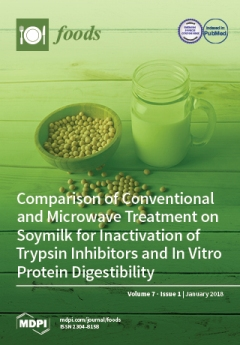This study compared the quality variation and thermal inactivation of
Escherichia coli O157:H7 in non-intact beef and veal. Coarse ground beef and veal patties (2.1 cm thick, 12.4 cm diameter, 180 g) inoculated with
E. coli O157:H7, aerobically stored before double pan-broiling for
[...] Read more.
This study compared the quality variation and thermal inactivation of
Escherichia coli O157:H7 in non-intact beef and veal. Coarse ground beef and veal patties (2.1 cm thick, 12.4 cm diameter, 180 g) inoculated with
E. coli O157:H7, aerobically stored before double pan-broiling for 0–360 s without rest or to 55, 62.5, 71.1, and 76 °C (internal temperature) with 0.5- or 3.5-min rest. Microbial population and qualities including color, cooking losses, pH, water activity, fat, and moisture content, were tested. After cooking the beef and veal patties, the weight losses were 17.83–29%, the pH increased from 5.53–5.60 to 5.74–6.09, the moisture content decreased from 70.53–76.02% to 62.60–67.07%, and the fat content increased (
p < 0.05) from 2.19–6.46% to 2.92–9.45%. Cooking beef and veal samples with increasing internal temperatures decreased a* and b* values and increased the L* value.
Escherichia coli O157:H7 was more sensitive to heat in veal compared to beef with shorter D-value and “shoulder” time. Cooking to 71.1 and 76 °C reduced
E. coli O157:H7 by >6 log CFU/g regardless of rest time. Cooking to 55 °C and 62.5 °C with a 3.5-min rest achieved an additional 1–3 log CFU/g reduction compared to the 0.5-min rest. Results should be useful for developing risk assessment of non-intact beef and veal products.
Full article






